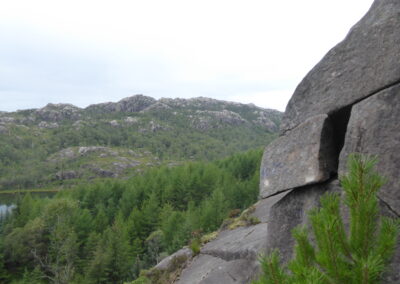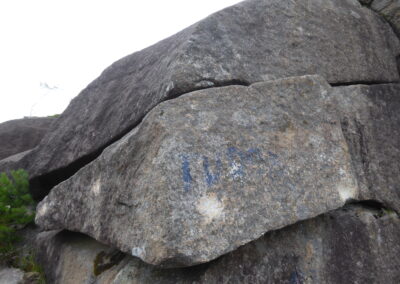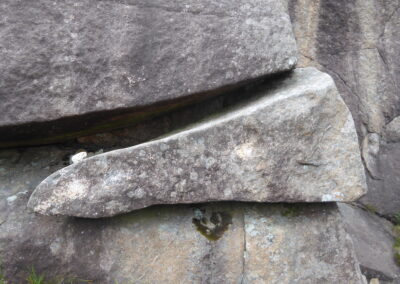The Singing Stone by Nedre Åmdal
Type: Klangstein
Local name: Syngaren
Locality
County: Rogaland
Municipality: Eigersund
Locationb: East of Espetjørna, Southwest og Nedre Åmdal (Omdal)
From Egersund, follow County Road 42 north about two km, then turn right on Slettebøveien (signposted Mjølhus). After 2.5 km there is a parking lot marked Trollpikken. From there you can either walk or cycle further–along Kjervallveien, on a gravel road through a pleasant cultural landscape. After 3.5 km—by Helgesvatnet—there is a marked path from the road leading to Syngaren. (In August 2021 the sign by Helgesvatnet had fallen down.) The path, about 750 meters, goes partly across bogs. NB: On Norgeskart.no and other maps, Syngaren is erroneously marked a couple of hundred meters too far north.
Description
The Singing Stone is a boulder that has come loose but is still stuck in the rock. It looks like it’s about to slide out of the west-facing knoll. Behind the block, towards the solid rock, there is about 20 cm of air. At the northern end, where the stone protrudes like a tongue, there is a cavity of about 30 cm up to the solid rock. The stone itself is 180 cm long (north–south), 110–120 cm wide (east–west), while the largest height is 80 cm.
The spectacular sound should be understood on basis of the special conditions, in combination with the density and structure of the stone. Some people have reported that also other stones in the close vicinity sing. Accordingly, the shape and special conditions of the Singing Stone is no explanation itself.
The sound is very similar to a church bell or a small village bell. The reverberation is surprisingly long, and the sound is echoed from the hill on the other side of Espetjørna. (The echo is probably best when there is bare frost.) The frequency is the same on the different spots of the stone, but strength and reverberation vary slightly. The very best sound is probably on the ‘tongue’–the tapering part pointing northwards. There are four distinct wear marks on the stone. The two largest and deepest marks on the south side, where there are still remnants of blue paint after someone once tagged ‘TUDOR’.
Cultural history and tradition
The Syngaren has long been known in the local community, also as a tour destination. Despite its location in an impassable area, the sound has carried far. A woman says that her mother, who grew up at Klungland, 2.5 km northwards, could hear the Singing Stone all the way there when someone hit it. Moreover, this woman believed that the Singing Stone sounded stronger earlier than it does now. In Årbok for Dalane (1990–92, p. 131) we can read that Syngaren is ‘a boulder that sounds like a church bell when you strike it, and is located just east of Espetjørna, about 1 km southwest of the farm Nedre Åmdal in Helleland. The stone has been known in the area since ancient times, and it is said that the sound from it under special weather conditions could be heard all the way to Hafsnøyna in Eigersund.’ The distance from the Singing Stone to Hafsnøya (Havsøya) in Egersund is more than 6 km. Apart from this, we have not come across any legends or stories about the Singing Stone. But as generally known in Dalane, people used to play on the singing stones to warn the underearthly beings: ‘Here we come!’





